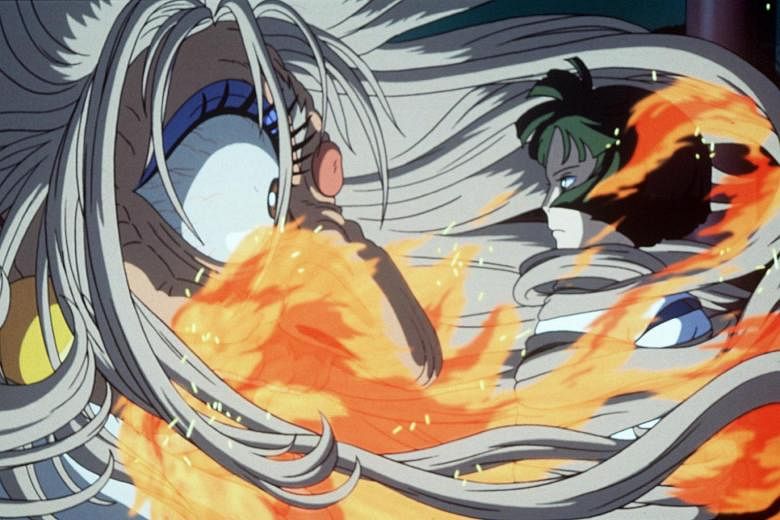It sometimes feels as though Japanese pop culture is under siege. Be it music, TV dramas or movies, the Korean contingent of boybands, girl groups and perfectly groomed idols has edged ahead in the popularity sweepstakes.
Japanese fare is not about to roll over completely, though. When it comes to animation, the Land of the Rising Sun is still going strong.
I went through an anime phase in the early 2000s and then drifted away from it. After a recent return to its embrace, I am happy to report that the world of anime remains as wacky, moving and entertaining as before.
Titles that I watched back then included the inventive space western Cowboy Bebop (1998-1999) with its awesome jazz soundtrack, the battle for one man's soul in the period actioner Rurouni Kenshin (1996-1998), the hilarious high-school comedy Azumanga Daioh (2002) and the sometimes head-scratching and so-cool-it-didn't-need-vowels sci-fi action series FLCL (2000-2001).
Studio Ghibli has international hits such as the fantasy adventure Spirited Away (2001) and the whimsically charming My Neighbour Totoro (1988), but there is much more to discover in anime films. The tip of the iceberg includes sci-fi techno-thriller Ghost In The Shell (1995) by Mamoru Oshii and the psychological thriller-horror flick Perfect Blue (1997) by Satoshi Kon, works which are far darker in tone than Ghibli's family-friendly works.
My diet included the popular ninja series Naruto (2002-2007), although the supersized serving of 220 episodes proved to be too much to swallow. A single fight could stretch to more than 10 episodes and I gave up somewhere past the 100-episode mark.
For a long while after that, I lost touch with the medium.
But thanks to a long-haul flight on Japan Airlines, I rediscovered the myriad joys of anime.
I stumbled across a two-episode offering of Haikyu!!, Japanese for volleyball, and was soon hooked. Even without English subtitles, the show draws one in with its crisp animation, exciting ballplay and sharp characterisation.
Haikyu!! is a typical offering in the sports genre, but it is executed well. It has you rooting for the underdogs as pint-sized Hinata and his team aimed for glory on the courts. And when the ball finally lands with a thud in a crucial game that spans six episodes, I gasped out loud.
One reason for the high quality in anime is the large volume of titles produced. Just this spring alone, the gaming and anime blog Kotaku presented a guide to 50 new titles.
Mind you, that is merely for one season and not for the year. Animators have had tens of thousands of hours of content to hone their skills and it shows.
Very often, they draw on existing manga. Given there are at least 10,000 titles of manga compilations published in a year (as estimated by manga artist Dan Kanemitsu in a 2012 blog post), only the top titles get to be animated. The quality of the source material already gives anime a leg-up.
Live-action films based on manga continue to find big audiences. Post-apocalyptic title Attack On Titan (2015) has grossed more than $820,000 at the Singapore box office.
After the excitement of Haikyu!!, I decided to get into anime again, trawling the Web for recommendations on the best titles of last year. I settled on sports title Ping Pong The Animation, slice-of-life series Barakamon about a calligrapher, and set-in-hell comedy Hozuki's Coolheadedness.
While Ping Pong and Haikyu!! both revolve around sports, they could not be more different. For starters, the animation in Ping Pong goes for a kind of ugly-realist style reminiscent of the rotoscoping done for the film Waking Life (2001). It also delves far more deeply into the psyches of the players. The ping pong games are depicted in an impressionistic manner as opposed to being the meat of the series.
Barakamon is in the slice-of-life genre and it offers gentle comedy and lessons in the tale of a calligrapher's exile to a remote island - 23-year-old Handa's friendship with the irrepressible six-year-old Naru is the heart and soul of this show.
Most unusual of the lot is Hozuki's Coolheadedness, an episodic look at the challenges faced by the unflappable Hozuki, chief of staff to the head judge of hell. The landscapes of the netherworld are beautifully rendered and draw inspiration from ukiyo-e woodblock print illustrations. The gleeful theme song can also lay claim to the title of catchiest song ever written about hell. (Hell by the American band Squirrel Nut Zippers is a close second.)
There has always been more to anime than advertised-as- entertainment-kiddy fare such as Pokemon. There are shows of every genre, from the sublime to the ridiculous, to cater to every taste.
One title I will be steering clear of, though, is Naruto: Shippuden. It started in 2007 and has clocked 429 episodes. And it is not over yet.


